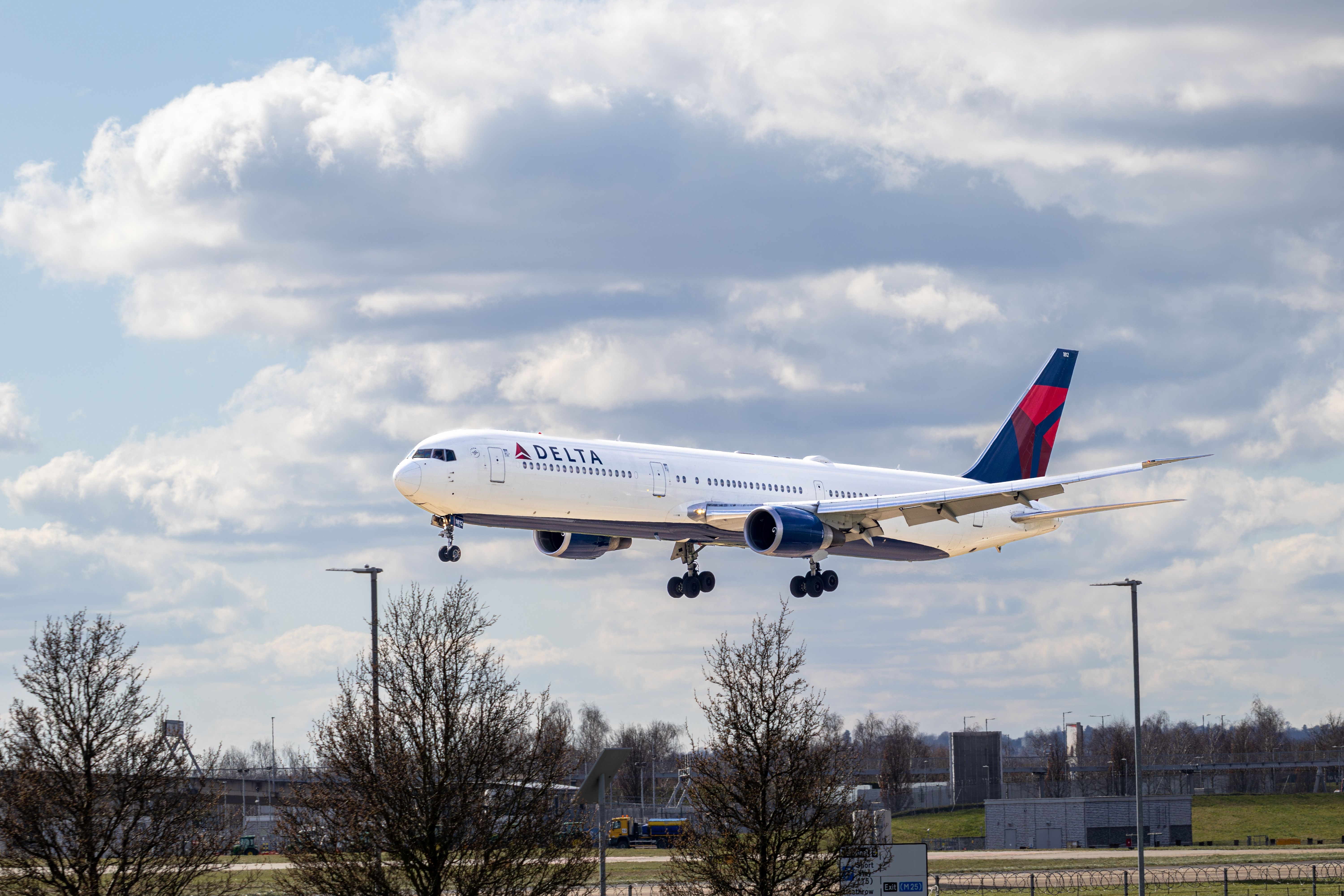The Boeing 767 has four wheels for both of its main landing gear (MLG) sets . Also known as bogies, these are the main support for the weight of the aircraft and are the first points of impact when the 767 lands. The bogies on the 767 also feature a tilt, in which one axle rises above the other when the plane is in the air.
Most aircraft with landing gear bogies feature a tilt. However, what's unique about the 767 is the fact that the gear tilts forward . On most commercial aircraft with four or six-wheel bogies, the gear tilts rearward.

Visually, the rear axle is lowered while the front axle is raised. This is the more common configuration in airliners, especially with Boeing's. In fact, the 767 is the only Boeing aircraft to feature a forward tilt.
Why is this? Making Everything Fit Into A Small Area Although planes appear big, aircraft engineers have to fit a lot of items into a relatively compact package. MLGs, for example, typically retract into the belly of an airplane, but this space is shared. Universally, the wingbox is big, structural, and goes in between the wings, right in front of the gear bays.
Many aircraft also include center fuel tanks, and emergency exit slides right behind the gear wells, along with a cargo hold. To make room for other items, the gear is tilted so that it takes up less space, and the gear well can be smaller. Other parts of the plane provide a benefit.
Fuel tanks are necessary, cargo holds provide extra revenue for airlines, and the wing box is a structural component. But gear wells don't do anything besides store landing gear. So engineers would rather tilt the MLG bogies and make the gear wells smaller.
The result? Of the current aircraft produced by Airbus and Boeing with four or six-wheel bogies, all except the Airbus A350-1000 have tilted landing gear. However, the A350-1000's six-wheel bogie is actually only slightly bigger than the four-wheel bogie on the A350-900, as its wheels are smaller and spaced much closer together. Combined with the design changes between the two planes, the A350-1000 doesn't require a tilt.
Aircraft Handling Gear tilt is common on aircraft, but a rear tilt is more common. The 767's forward tilt is a less popular choice, especially among Boeing aircraft. The reason for the 767 to have a tilt is to fit into the gear bays.
However, the reason why it tilts forward is primarily due to aircraft handling . The Boeing 767 is renowned as a pilot's aircraft. In fact, similar to the 757 that its pilots also fly, the 767 is incredibly powerful, and features lighter controls that some pilots prefer, making it fly more like a grand tourer rather than a sports car like the 757.
However, during testing, engineers discovered that the 767 tended to rapidly pitch down during landing. Specification Boeing 757 Boeing 767 EIS 1983 1982 Configuration Single-aisle twinjet Twin-aisle twinjet Variants 757-200, 757-300, 757-200F 767-200, 767-200ER, 767-300, 767-300ER, 767-400ER, 767-200F, 767-300F Type rating B757/767 B757/767 Engines Pratt & Whitney PW2000, Rolls-Royce RB211 General Electric CF6, Pratt & Whitney JT9D, Pratt & Whitney PW4000, Rolls-Royce RB211 Number produced 1,049 1,430 It can be dangerous for a plane to suddenly pitch down when pilots are landing, as this can put excessive strain on the nose gear and cause structural damage. In fact, exactly this happened to a United 767-300ER in 2023 when the nose gear was allowed to slam into the runway, which wrinkled the fuselage.
To help counter this, engineers had the gear tilt forward. The front axles touching first helps alleviate this pitch-down motion, though pilots must still be cautious to prevent the plane from pitching down. Twenty years after being out of production, the Boeing 757 is noted for being one of the airliners most loved by pilots.
Other Benefits Of Tilted Landing Gear Aircraft include sensors that inform the plane's onboard computer when the aircraft is on the ground or in the air. For planes with tilted gears, the sensor can detect when one wheel axle is on the ground. A rear tilt is also specifically beneficial for landings.
When the rear landing gear touches the ground first, this produces an effect that lowers the nose as the front axles lower, generally making landings smoother. This is especially noticeable on the Airbus A330 and A340. The Boeing 777-300ER also introduces a unique feature in that the MLG bogies are semi-levered .
Essentially, the front axles lift off the ground as the aircraft begins to rotate, which increases lift and reduces takeoff distances. Other aircraft, including the rest of the 777 family, have their gear stay fully down until the plane has completed its rotation. In a way, the 777-300ER's gear helps lift it into the air.
Aircraft Gear arrangement Tilt direction Airbus A320-200 (Air India) Four-wheel bogie Forwards Airbus A330 Four-wheel bogie Rear Airbus A340 Four-wheel bogie (wing), two center wheels (A340-200/300), four-wheel center bogie (A340-500/600) Rear (wing), forwards (center) Airbus A350 XWB Four-wheel bogie (A350-900), six-wheel bogie (A350-1000) Forwards (A350-900), no tilt (A350-1000) Airbus A380 Four-wheel bogie (wing), two six-wheel center bogies Forwards Boeing 747 Four-wheel bogie (wing), two four-wheel center bogies Rear (wing), no tilt (center) Boeing 757 Four-wheel bogie Rear Boeing 767 Four-wheel bogie Forwards Boeing 777 Six-wheel bogie Rear Boeing 787 Dreamliner Four-wheel bogie Rear Aircraft gear tilt is a simple solution to help gear bogies fit into compact gear wells, but engineers have since innovated to add extra features. Additionally, the Airbus A330 and A340 are known for having some of the smoothest landings of any airliner in service, while the Boeing 777-300ER uses it as a takeoff aid. What was a simple solution to an engineering problem is now a package of various design features.
Aircraft Gear Tilt In The Past And Today Aircraft have long existed with four-wheel gear bogies, but gear tilt was not initially a concept. Neither the Boeing 707 nor the Douglas DC-8 had tilted MLGs. The Boeing 747 had a complex gear arrangement with four sets of MLG bogies, so the MLGs under the wings featured an extreme rear tilt to fit into compact gear bays.
That way, there was space for the center gear sets. However, the McDonnell Douglas DC-10, Lockheed L1011 Tristar, and Airbus A300 did not feature gear tilt. The Boeing 757 and 767 feature tilted bogies, and since then, almost every newly designed widebody incorporates this design.
While Boeing has since favored rear landing gear tilts, Airbus has used both. The A330 and A340, which were released in the 1990s, both feature rear-tilting landing gear, while the newer A380 and A350-900 use a forward tilt. As discussed previously, the A350-1000's gear is not tilted.
Unique to the Boeing 777 and the 787 Dreamliner is that the gear changes its tilt. Although both planes feature rear tilts while in flight, the bogies actually rotate to a forward tilt when the gear is retracted, likely due to the design of the gear well. When the landing gear is lowered for landings, the gear once again moves to a rear tilt.
Covering the various processes involved. Hard landings Here's the trouble with a forward gear tilt. If you've ever been on a Boeing 767, an Airbus A350, or an A380, you may have noticed that landings can be quite firm.
As previously discussed, a rear tilt tends to soften landings, an effect especially pronounced on A330s and A340s. But when the front wheel axle touches down first, this tends to pull the rear axle down onto the ground, setting the full weight of the plane onto the ground more quickly. Since the release of the 767, Boeing has seemingly decided to avoid this.
As mentioned before, the 777 and 787 both change the angle of their MLG tilt to be rearwards, which allows for a smoother landing. Giving these planes an extra mechanism for this tilt change adds cost and complexity, but for Boeing, it was worth it to make these aircraft easier to land smoothly. Specification Boeing 777 Boeing 787 Dreamliner EIS 1995 2011 Configuration Twin-aisle twinjet Twin-aisle twinjet Variants 777-200, 777-200ER, 777-300, 777-200LR, 777-300ER, 777F, 777-8, 777-9 787-8, 787-9, 787-10 Number of MLG wheels per set Six Four Engines General Electric GE90, Pratt & Whitney PW4000, Rolls-Royce Trent, General Electric GE9X General Electric GEnx, Rolls-Royce Trent 1000 For Airbus, they decided to simply let the gear hang forward on the A380 and A350-900, evidently prioritizing simplicity.
This shows the different design priorities between Airbus and Boeing, with the companies differing on a wide range of features ranging from flight deck controls to wingtip devices as well as landing gear designs. The Rundown Pilots often laud Boeing aircraft for their performance and handling characteristics. Although the 767's landing gear isn't ideal for producing greasers, in this case, it was a conscious choice to help pilots land the aircraft safely.
After all, a firm landing is better than smashing the nose gear into the ground. Furthermore, tilted landing gear has now become a ubiquitous feature on large airliners. Nearly all aircraft incorporate this to fit into more compact gear wells, allowing engineers to make more room for other items.
Although Airbus and Boeing differ in their approach to this, these differences help distinguish each plane from one another, adding more variety to an increasingly homogenous sky. Did you know that the first retractable landing gear was developed in 1911?.
Top

Why In The World Does The Boeing 767's Landing Gear Tilt Forward?

Firmer landings, but for a reason.











